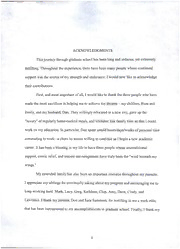Table Of ContentFACILITATINGANALOGICALTRANSFER
INAHYPOTHETICO-DEDUCTIVEREASONINGTASK:
THECONTRIBUTIONSOFSURFACEANDSTRUCTURALSIMILARITY
I
CYNTHIASUMMERSKOENIG
ADISSERTATIONPRESENTEDTOTHEGRADUATESCHOOL
OFTHEUNIVERSITYOFFLORIDAINPARTIALFULFILLMENT
OFTHEREQUIREMENTSFORTHEDEGREEOF
DOCTOROFPHILOSOPHY
UNIVERSITYOFFLORIDA
2002
ACKNOWLEDGMENTS
Thisjourneythroughgraduateschoolhasbeenlongandarduous,yetextremely
fulfilling.Throughouttheexperience,therehavebeenmanypeoplewhosecontinued
supportwasthesourceofmystrengthandendurance.Iwouldnowliketoacknowledge
theircontributions.
First,andmostimportantofall,Iwouldliketothankthethreepeoplewhohave
madethemostsacrificesinhelpingmetoachievemydreams-mychildren,Russand
Emily,andmyhusband,Dan.Theywillinglyrelocatedtoanewcity,gaveupthe
"luxury"ofregularlyhome-cookedmeals,andtoleratedlessfamilytimesothatIcould
workonmyeducation.Inparticular,Danspentuntoldhours/days/weeksofpersonaltime
commutingtowork-achoreheseemswillingtocontinueasIbeginanewacademic
career.Ithasbeenablessinginmylifetohavethreepeoplewhoseunconditional
support,comicrelief,andsincereencouragementhavetrulybeenthe"windbeneathmy
wings."
Myextendedfamilyhasalsobeenanimportantresourcethroughoutmypursuits.
Iappreciatemysiblingsforcontinuallyaskingaboutmyprogressandencouragingmeto
keepworkinghard:Mark,Lucy,Greg,Kathleen,Chip,Amy,Dave,Cindy,and
Lawrence.Ithankmyparents,DonandSaraSummers,forinstillinginmeaworkethic
thathasbeeninstrumentaltomyaccomplishmentsingraduateschool.Finally,Ithankmy
ii
in-laws,HarryandBettyKoenig,notonlyforbeingsupportiveovertheyearsbut
especiallyforraisingsuchafinesonwhohasbeenanessentialelementinmysuccess.
IappreciatethecontributionsofthefacultymembersattheUniversityofFlorida
whoprovidedadvice,expertise,andsupportduringthedevelopment,datacollection,and
writingofthisdissertation:myfacultyadvisorandcommitteechair.Dr.RichardGriggs,
andfourcommitteemembers.Dr.fraFischler,Dr.ShariEllis,Dr.JeffFarrar,andDr.
JamesAlgina. Ithasbeenaprivilegetoworkwithindividualswhoseuniquetalentshave
contributedsignificantlytomyprofessionaldevelopmentduringgraduateschool.
Havingfellowgraduatestudentsandfacultywhoprovideencouragement,
fiiendship,andstressreliefenhancessuccessingraduateschool.Ihavebeenfortunateto
haveanumberofstudentsandfacultymemberswhoprovidedmentoring,advice,and
emotionalsupportthroughoutgraduateschool.IthankLisaMaagforhercomicrelief,
DuanaWelchformentoringmethroughmyfirstyearofgraduateschool,Jennifer
Blessingforherstatisticalwizardry.Dr.ShariEllisforbeingbothagreatfiiendanda
rolemodel,andDr.JeffFarrarforhisnever-endingsupport.
Finally,IwouldliketoexpressmysincereappreciationtoDr.RichardGriggs.At
atimewhenmygraduatecareerwaslookingratherbleak,hetookmeunderhiswingand
helpedto"polish"myedgessothatImightbecomeabetterresearcher,teacher,and
colleague.Ithasbeenaprivilegetoworkwithsomeonewhonotonlysharesasimilar
teachingphilosophyandworkethicbutwhohasbeentirelessinhissupportofmy
academicpursuits.Iwillbeeternallygratefulforhismanycontributionstobothmy
graduatecareerattheUniversityofFloridaandmyupcomingacademiccareeratSt.
Mary'sCollegeofMaryland.
iii
;^^^ TABLEOFCONTENTS
\ ' ' ^ , ~ page
..
ACKNOWLEDGMENTS ii
ABSTRACT vi
CHAPTER
1 INTRODUCTION 1
TheoreticalExplanationsofAnalogicalTransfer 4
TheTHOGTask 9
TheoriesofReasoningandtheTHOGTask 10
FacilitationontheTHOGTask 13
AnalogicalTransferandtheTHOGTask 18
Summary 24
2 OVERVIEWOFDISSERTATIONEXPERIMENTS 26
3 DESIGNANDMETHODOLOGYOVERVIEW 30
Participants 30
Procedure 30
Materials 30
SimilarityQuestionnaire 31
ErrorPatterns 31
4 EXPERIMENT1-TESTINGFORTRANSFER 33
Introduction 33
DesignandMethodology 33
Results 35
Experiment1Conclusions 40
5 EXPERIMENT2-CHANGINGTHEVALUESOFTHEDIMENSIONS 43
Introduction 43
DesignandMethodology 43
Results 45
iv
Experiment2Conclusions 51
6 EXPERIMENT3-CHANGINGTHEDIMENSIONS 54
Introduction 54
DesignandMethodology 55
Results 57
Experiment3Conclusions 60
7 EXPERIMENT4-EXAMININGSTRUCTURALFEATURES 63
Introduction 63
DesignandMethodology 64
Results 65
Experiment4Conclusions 70
.1]
8 SUMMARY 72
SurfaceandStructuralSimilarity 72
SeparationandHypothesisGeneration 73
FacilitatingAnalogicalTransfer 74
ReconsideringtheTHOGTask 76
REFERENCES 80
APPENDIX
A STANDARDTHOGPROBLEM 84
B VARIANTSOFTHETHOGPROBLEM 85
C ADDITIONALEXPERIMENTALMATERIALS 92
D ERRORPATTERNS 96
BIOGRAPHICALSKETCH 99
V
AbstractofDissertationPresentedtotheGraduateSchool
oftheUniversityofFloridainPartialFulfillmentofthe
RequirementsfortheDegreeofDoctorofPhilosophy
FACILITATINGANALOGICALTRANSFER
INAHYPOTHETICO-DEDUCTFVEREASONINGTASK:
THECONTRIBUTIONSOFSURFACEANDSTRUCTURALSIMILARITY
CynthiaSummersKoenig
,
August2002 ,
Chair:RichardA.Griggs
MajorDepartment:Psychology
TheBlackboardandPythagorasversionsoftheTHOGproblemwereutilizedto
investigatehowsurfaceandstructuralsimilaritycontributetoanalogicaltransferinthis
hypothetico-deductivereasoningtask.Inexperimentalgroupsof12orfewer,466
UniversityofFloridaintroductorypsychologystudentsseparatelysolvedsourceand
targetproblems,andthendescribedanyproblemsimilaritiesandtheirfacilitatingeffects.
InExperiment1,significanttransferwasobservedforbothTHOGproblemswhen
surfacesimilaritybetweensourceandtargetproblemswasmaintained.InExperiment2,
changingthedimensionalvaluesofthegeometricfiguresinthetargetproblemdecreased
surfacesimilarity.ThePythagorasproducedanalogicaltransferwhereastheBlackboard
didnotandwasdroppedfromfurtherexperimentalinvestigation.InExperiment3,the
targetproblem'sgeometricdesignswerereplacedwiththedimensionsoflettersand
vi
numbers,andthePythagorasagainyieldedtransfer.InExperiment4,threeversionsof
thePythagorasproblemwerecreated,andahypothesisgenerationrequestincombination
witheitherfigurallabelingornarrativestructureproducedanalogicaltransfer.
Theseexperimentsrevealedthatparticipantscouldsolvethedifficultabstract
THOGtask,intheabsenceofsurfacesimilarity,iftheyabstracteditssolutionprinciple
fromasourceproblem.Whensurfacesimilaritywasreduced,itwasnecessaryforthe
sourceproblemtoentailfeaturesthatseparatedthevaluesoftheexemplarfromthe
possiblewrittendowncombinationsandrequestedparticipantstogeneratehypothesesfor
thesecombinations.Thesefindingscontributetoourunderstandingofbothhypothetico-
deductivereasoningandanalogicaltransfer.First,confiisiontheorywassupportedbythe
findingthatseparationandreducedworkingmemoryloadyieldedbothfacilitationand
fransfer.Second,indirectexperimentalhelp(i.e.,ahypothesisgenerationrequest)was
necessarytoobtaintransfer.Finally,theprimacyofstructuralsimilaritytoanalogical
transferwasinterpretedassupportingpragmaticschematheoryandstructuremapping
theory.Theseresultssuggestthemajorityofadultscanreasonhypotheticallyand
deductivelyontheTHOGtaskiftheyareledtoabstractitsunderlyingsolutionprinciple.
' - .
* ' '
vii
CHAPTER
1
INTRODUCTION
Thedoctrineof"formaldiscipline,"datingbacktotheteachingsofPlatoand
presentedinitsclassicformbyJohnLocke(Dewey,1916),inmanyrespectsliesatthe
heartofspontaneousanalogicaltransfer.Accordingtoformaldiscipline,themindislike
a"muscle"thatmustbetrainedincertainfaculties,suchasobservation,attention,and
reasoning,inordertostrengthentheseprocesses(Singley&Anderson,1989).Locke
believedthecontentstudiedinorderto"exercise"thesefacultiesv^^assomewhat
irrelevant.Rather,heproposeditwastheamountofexertionrequiredtomasteragiven
abilitythatwasmostimportant(Dewey,1916).Theprimarypurposeofformaleducation
then,asproposedbyformaldiscipline,shouldbetofocusonthosecontentareaslikelyto
trainspecificcognitiveprocessesthatcanthenbeapplied(transferred)acrossmany
disciplines.
ThefirsttoempiricallytestthetenetsofformaldisciplinewasE.L.Thomdike
(1906,1913).Inaresearchendeavorspanningoveraquartercenturyusingavarietyof
tasks,Thomdikedeterminedthatthetypeofspontaneoustransferproposedtoresultfrom
formaldisciplinetrainingwasentirelytoowideinscope.Hesuggestedthatratherthan
entailingparticularfaculties,themindiscomposedofspecificassociationsandhabits
thatnarrowdramaticallythetypesofresponsesthatcanbeexpectedinanygiven
situation.Asaconsequence,transferbetweenactivitiesshouldonlybeexpectedifthere
isahighdegreeofsimilarity(i.e.,sharedcommonstimulus-responseelements).
1
2
Thomdike'stheoryoftransfer,calledthetheoryofidenticalelements,proposedthat:
Onementalfunctionoractivityimprovesothersinsofarasandbecausetheyare
inpartidenticalwithit,becauseitcontainselementscommontothem.Addition
improvesmultiplicationbecausemultiplicationislargelyaddition;knowledgeof
LatingivesincreasedabilitytolearnFrenchbecausemanyofthefactslearnedin
theonecaseareneededintheother...[T]hemindissospecializedintoa
multitudeofindependentcapacitiesthatwealterhumannatureonlyinsmall
spots,andanyspecialschooltraininghasamuchnarrowerinfluenceuponthe
mindasawholethanhascommonlybeensupposed.(Thomdike,1906,pp.243-
246)
Thus,althoughThomdikerejectedthestrongtheoryoftransferproposedbyformal
discipline,hedidacceptaweakerversionsuggestingthattraininginagiven
disciplineisonlylikelytotransfertoothersituationsifthereareidentical"elements"
thatcanbemappedontoeachother.
Theabilitytotransferknowledgefromoneexperiencetoanotherhasbroad
implicationsacrossavarietyoftasksinaneducationalsetting(e.g.,working
mathematicsproblems,learningforeignlanguages,andapplyingtherulesof
science).Transferalsoplaysanimportantroleineverydayreasoninganddecision-
makingbecausepreviousexperiencescanbeutilizedtoelucidateandbenefit
subsequentsimilarexperiences.Perhapsbecausetheeducationenvironmentisonein
whichsuccessful/unsuccessfiiltransferismoreeasilymeasuredquantifiably,much
oftheresearchonanalogicaltransferhasfocusedonproblemsolvingtasks.
Inthetypicaltransfertask,problemsolversarepresentedwitheitherasolvedor
to-be-solvedproblem(thesource)thatisexpectedtofacilitateperformancewhenan
analogicallysimilarunsolvedproblem(thetarget)islaterpresented.Thereisconsensus
amonganumberofresearchers(e.g.,Holyoak&Koh,1987;Mandler&Orlich,1993;
Needham&Begg,1991;Novick,1995;Reeves&Weisberg,1994)thatinorderfor
3
successfulanalogicaltransfertooccur,theproblemsolvermustbeableto(a)constructa
mentalrepresentationofthesourceandtargetproblems,(b)selectthesourceproblemas
arelevantanalogforsolvingthetargetproblem,(c)maptherelevantcomponents
betweenthesourceandtarget,and(d)extendthismappingtogenerateasolutiontothe
targetproblem.
• Inordertomentallyrepresentthesourceandtargetproblems,theproblemsolver
needstoinitiallyencodevariousproblemcomponents,eachofwhichmayhavevarying
degreesofinfluenceonthetransferprocess.Someresearchers(e.g.,Gick&Holyoak,
1980,1983;Centner,1983)arguethatmostrelevanttosuccessfultransferisabstracting
thedeepstructureofaproblem,whichmaintainsits"essence"irrespectiveofitscontent.
Thisissometimescalledtheproblem's"solutionprinciple"andcanbeaformula(asin
algebra,physics,orlogic),aproposition(e.g.,"Alargeforcemustbebrokenintosmaller
elementsandsummateonatargetinordertoachieveagoal"),orarule(e.g.,"Afigure
willbeclassifiedasaTHOGif,andonlyif,itcontainseitherthecolororshapeIhave
writtendown,butnotboth")(Reeves&Weisberg,1994).Infact,ifthesolutionprinciple
isnotencoded,transferisnotexpectedtooccur.
Thesurfacecontentsofthesourceandtargetproblemsshouldalsobeencodedin
suchamaimerthattherelationsbetweenthemareeitherirrelevanttoorinstantiatethe
solutionprinciple.Forexample,intheTHOGruleexampleabove,thespecific
dimensionsofshapeandcolorareessentiallyirrelevanttosolvingthetask,whereasthe
relationshipsamongthedimensionalvalueswrittendown,theTHOGrule,andagiven
exampleofaTHOGcomprisetheessenceofthesolutionprincipleandthusneedtobe
encodedtofacilitatetransfer.

